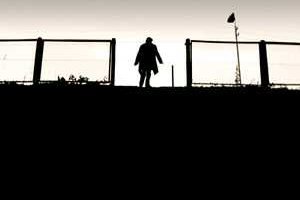 Fred Kelemen's trilogy Fate (1994), Frost (1997) and Nightfall (1999) brought him international attention during the last decade on the strength of his anti-aesthetic, staunchily cinephilic evokation of an uncertain, transitional Europe filtered through his Eastern European sensitivity (Kelemen was born in Berlin to a Hungarian mother). His films are rigorous, uncompromising formal experiments that go against the grain of contemporary cinema in every respect. A disciple of the Hungarian Béla Tarr, he was hailed by the late Susan Sontag as one of the last gasps of twentieth-century cinephilia. His films tap into post-Communist bleakness where rambling characters navigate the uncertainties of their times, estranged from reality and drinking copious amounts of alcohol. Kelemen takes cinema's dark cave metaphor to an almost literal end.
Fred Kelemen's trilogy Fate (1994), Frost (1997) and Nightfall (1999) brought him international attention during the last decade on the strength of his anti-aesthetic, staunchily cinephilic evokation of an uncertain, transitional Europe filtered through his Eastern European sensitivity (Kelemen was born in Berlin to a Hungarian mother). His films are rigorous, uncompromising formal experiments that go against the grain of contemporary cinema in every respect. A disciple of the Hungarian Béla Tarr, he was hailed by the late Susan Sontag as one of the last gasps of twentieth-century cinephilia. His films tap into post-Communist bleakness where rambling characters navigate the uncertainties of their times, estranged from reality and drinking copious amounts of alcohol. Kelemen takes cinema's dark cave metaphor to an almost literal end. His new film, Krisana (Fallen), a German/Latvian production, sees Kelemen continue with his pursuit of the same aesthetic and production mode that brought him a certain degree of fame in the 1990s. In other words, he financed the film himself to keep his artistic view free from economic pressure. The result is brave and unique in the context of today's homogeneous film scene. There is no doubt about Kelemen's confidence as a director and his defiance is admirable. In Krisana, a super-noir DV take on the Blow Up template of photographic voyeurism, he takes the viewer to a place of loneliness and paranoia, but without ever providing any kind of relief or failing to sustain the atmosphere of the film. Set in Latvia, the Krisana captures the country's post-Communist spectrum mercilessly, seen through the eyes of an archivist who gets obsessed with piecing together the life of a woman he failed to save from suicide at a bridge. He manages to find her purse at a bar and from there he tracks her address and her boyfriend. His life is a void and glimpses into someone's else life seem to provide a ray of light into the archivist's dark-side-of-the-moon world.
Structured with very clear-cut sequences, the film is photographed with rigidly formal cinematography. The overall result is uneven. Shot on black and white DV, Kelemen avoids the hand-held aesthetics that most film-makers adopt when shooting on digital; he opted for a more celluloid-like approach to the cinematography. Sometimes it works, sometimes it doesn't. The flatness of the image, which is often an asset to convey a type of immediate realism that in the hands of Lars Von Trier and Lukas Moodysson translate into throbbing emotional texture, in Krisana seems more like an inedequacy and not exactly a de-constructivist manifesto against the idea of 'cinematic purity'. The sound design of the film, a humming dirge of industrial echoes, plays an important role in keeping the organic unity. The director's mastery over rhythm also makes up for its shortcomings. Tristana is a significant film and Kelemen's unique voice from the "other Europe' is a force to be reckoned with. It takes time to get through the density of his vision, but Kelemen rewards those who persist.
Tristana is playing at the Ciné Lumière and the Tate Modern in London.












